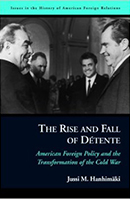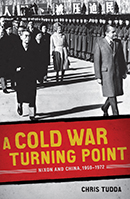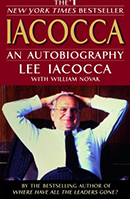Predicaments of American Cars
By Moses Lee

Lee Iacocca
Lee Iacocca, originally Lido Iacocca, was born in Allentown, Pennsylvania, 1924 from Italian immigrants. After attending Lehigh University and subsequently Princeton, Iacocca joined Ford Motor Company. Becoming president of Ford in 1970 then Chrysler in 1979, Iacocca is hailed as the American Auto Icon for his brilliance in the Mustang and the Cougar.




The 1970s was a time of vicissitude for American auto industries. With many problems like the oil crisis of 1973, prominent American auto companies like Ford and General Motors had trouble keeping up with Japan’s small and energy efficient cars. In Iacocca: An Autobiography, Lee Iacocca, “[tells] the story of [his] life at Ford and at Chrysler the way it really happened.”1 Iacocca tells his version of events with detail from his coming of age to presidency at Ford, and later Chrysler. Albeit biased at times, Iacocca tries to objectively tell his life story and his experiences in the auto industry.
Lee Iacocca, originally Lido Iacocca, was born and raised in Allentown, Pennsylvania in 1924. Child of Italian immigrants Nicola and Antoinette Iacocca, Iacocca faced a lot of prejudice. He faced segregation in school from other students and even teachers. To hide his heritage and have better chances in business, Iacocca later changed his name from Lido to Lee. His father Nicola had many experiences with business. He once owned a hot-dog restaurant, a sandwich shop, and even a car rental agency. Lee’s father was skilled in marketing, “probably responsible for [Iacocca’s] instinct in marketing.”2 While growing up, Iacocca faced the Great Depression during 1930s and World War II. Iacocca’s frugality was the result of the penury he faced during the Great Depression. When the Pearl Harbor was bombed in 1941, Iacocca gained a sense of patriotism and wanted to participate in the war. However in his school days, Iacocca contracted rheumatic fever, which later prevented him from participating in World War II. Iacocca loved to read and had interests in many other areas like jazz and politics. He had a discrete passion in automobiles, which he gained from his father’s car-rental business, and attended Lehigh University to study industrial engineering. After graduation, he attended Princeton to further his studies. Since most students were drafted, Iacocca easily gained quality education and became a student engineer at Ford in 1946.
When Iacocca joined Ford to become an engineer, he was unsatisfied. He found engineering mundane and decided to pursue sales. During the mild recession of the 1950s, Iacocca married Mary McCleary in 1956. Continuing on to the 1960s, Volkswagen took lead in the auto industry with their fuel efficient cars. Ford’s response was the Cardinal: a small, simple, inexpensive car. It was a disappointment for Iacocca and he decided to shut the project down and start a new one. Iacocca, who was now a general manager of the Ford division, wanted to come up with a new car that would bring Ford back to the top. Iacocca tried to design a car that would appeal to several markets by making, “one basic car with a wide range of options.”3 This new car would become the renowned Mustang. The Mustang was released in 1964 at New York World’s Fair and it was a hit. The Mustang, Cougar, and Mark III, which were all built under Iacocca, put Ford back to the top in America. The amount of success under Iacocca made him the new president of Ford in 1970. As Iacocca took the throne, the Arab-Israeli war lead to the unfortunate Oil Crisis of 1973. This was a devastating blow to Ford and other American auto industries. Since oil prices went through the roof, Americans found small and fuel efficient cars favorable. Japan car companies like Honda and Toyota, “had most of the small cars, and they were selling like crazy.”4 To add on to the series of unfortunate events, Henry Ford II and Iacocca clashed at work starting from 1975. Henry Ford II was near insane. He created an irrational rivalry between himself and Iacocca. Ford believed that when he died, Iacocca would take over and remove the Ford name. In order to prevent this, Ford started his plan to destroy Iacocca. From spying on workers and eliminating assets, Ford got out of his way to get rid of him. Even firing those close to Iacocca, Ford destroyed him little by little. Finally, in 1978, to America’s surprise, Lee Iacocca, the father of the Mustang, was fired from Ford.
When Iacocca was fired from Ford, he was devastated. His family was distressed and Iacocca lost all his friends from his previous company. If anyone from Ford were to be caught with Iacocca, Henry Ford II would have fired them. Full of vexation and not willing to capitulate, Iacocca continued to pursue the auto industry. He was asked to lead Chrysler and became its president in 1979. With the energy crisis as well as the 1978 recession, Chrysler was near bankrupt. When Iacocca first came into Chrysler, it was a mess. Everyone in the company worked independently without adequate communication and systematics. Iacocca had to first build his team and change many policies at Chrysler. Subsequently, “[he] had to lay off thousands of workers, blue-collar and white-collar alike.”5 Even after all that, Chrysler had to go to the government to ask for a loan guarantee. Although the process was tedious, Chrysler finally received 1.2 billion dollars. Iacocca even reduced his annual salary to a dollar; calling it “equality of sacrifice.” Many were skeptical whether Iacocca could turn the company around or not. Nonetheless, Iacocca released a new, American, fuel-efficient, front-wheel-drive car, called the K Car. Iacocca’s persistence inspired many and he gained support from celebrities such as Bill Cosby, Pearl Bailey, and Frank Sinatra. In 1981, Chrysler was down to its last one million dollars and had to ask the government for an additional four hundred million dollars. The economy began to heat up in 1982 and by the next year, Chrysler made nine hundred twenty-five million dollars, which was the best in its history. In order to publicize and promote Chrysler as a new company under new leadership, Iacocca took the privilege to make appearances on advertisement. Within weeks, Iacocca became a minor celebrity of somewhat. By 1983, the loan was paid back in full, 7 years early, and Chrysler was back on its feet.
Iacocca concludes in the “Straight Talk” by offering his opinions on economical, social, and political affairs during this time. Iacocca is an advocate for seatbelts and believes seatbelts should be a requirement for all drivers. He also supports the middle class, however he believes some regulations made by the union are detrimental. Iacocca then criticizes the American government for falling behind in the world’s economy. He believes Japan is becoming economically superior because of the many advantages Japan has over the United States. For one, Japan had low taxes and the government supported the auto industry. He believes that America’s free trade is nonsensical since, “Japan has its own rules, so we’re constantly at a disadvantage.”6 Japan has its own “free trade”, which allows many advantages over America. Iacocca believes that in order to make America great again, America needs to, “promote both [high technology and basic industries] together.”7 He adds that American workers lack flexibility and discipline that Japanese workers are known for. Iacocca later becomes the chairman of the Statue of Liberty-Ellis Island Centennial Commission. He believes America is a melting pot of immigrants and corroborates the freedom which America stands for.
Iacocca’s thesis is fairly evident and it occurs perpetually. He states his thesis in an opening word, saying, “[he] wrote this book to set the record straight,” and to paint a realistic picture of business.8 As former presidents of Ford and Chrysler, both illustrious automobile companies back then, his side of the story has inevitably been tainted by media and rumors. With his conflicts between Henry Ford II and his decision to go to the government for help when he was at Chrysler, many versions of the story have been fabricated. Iacocca’s intentions of setting the record straight is very evident throughout his work. Iacocca uses a lot of quantifiable information in order to stay as objective as possible. By using amount of money, number of people, or number of sales, he portrayed his side during the Ford-Chrysler affairs. Iacocca also portrayed a realistic view of the business world pretty well. The unfairness and ruthlessness of the business world is shown through his experiences with Henry Ford II and the oil crisis.
Although Iacocca tries to be objective for the most part (excluding the “Straight Talk”), there is still some bias. As an Italian, “[he] took a lot of abuse for being different.”9 Coming from prejudice, Iacocca favors immigrants and the melting pot of America. As a man who came from nothing, he is a firm believer in quality leadership. Another one of his books, Where Have All the Leaders Gone?, is a testament to his priorities. His leadership is based on respect and discipline. When he first became the president at Chrysler, he says he was disgusted by the poor management skills and lack of respect from the workers for their superiors. Iacocca is also very subjective towards Henry Ford II. When Ford fired Iacocca in 1978, it was devastating to Iacocca. Iacocca perpetually repeats his loathing towards Henry Ford II, calling him a man-child and a dictator. Whether his name callings are justified or not, it is clearly biased.
Iacocca’s autobiography was written throughout his career at Ford and Chrysler during the 1970s. During this time, there was a lot of bigotry towards the Japanese, especially in the auto industry. Due to the oil crisis, many Americans sought out small, fuel efficient cars. Japan, who has been making small cars ever since World War II, dominated the American automobile market. Their superior presence in American automobiles was the source of the fiscal problems Iacocca faced at Ford and Chrysler during the 1970s. Although there was heavy competition between the Japanese, Iacocca made a deal with a Japan auto company, “Honda would supply us with three hundred thousand power trains a year at a price of $711 each.”10 Nevertheless, Henry Ford II refused to work with the Japanese. Dropping sales of American cars during the 70s due to the oil crisis and Japanese cars were the core causes of the tribulations Iacocca faced during this period. Because of many complications, Iacocca wrote this book as means of setting the record straight and to draw a realistic picture of the business world.
Reviewers acclaim Iacocca for his genius of the Mustang as well as his abilities to turn “Chrysler from near bankruptcy to solvency.”11 They admire his strong leadership skills and his aptitude for management. Magill Book Reviews calls the book an American in the outlook, with the message being achieving success through hard work. However, some disagree with some of Iacocca’s policies. Terry W. Hartle believes Iacocca’s “arguments for an industrial policy are shallow, and his descriptions of its elements are flimsy.”12 He criticizes Iacocca’s methods to beat Japan and bring the United States back to the top. Regardless, both Magill Book Reviews and Hartle laud Iacocca’s rise to presidency and his abilities to save a hopeless company.
Iacocca: An Autobiography is a story of a man who started from the bottom and rose to the top. Iacocca tries to tell his side of the story during the many complication which arose in the 70s. In the introduction of the book, Iacocca frankly states his reasoning for this book. His motives were not money or fame but to simply set the records straight. Starting from his earlier life, Iacocca foreshadows his upbringings. From his father who owned many businesses and the prejudice he faced all lead to the man he became. Iacocca utilizes common words to explain complex business terms although he gets too much in detail with numbers. Iacocca effectively describes the American auto companies in chaos, “I took one look at that system and I almost threw up.”13 Whilst Iacocca does not go deeper into the predicament with Japan, he describes the conditions of the auto industry pretty well. His experiences at Ford and Chrysler during the 1970s can be described as Hell. Clashing with Henry Ford and turning Chrysler around, Iacocca paints the challenging conditions of business. His systematic way of shaping companies is evidence of his strong leadership abilities. There is some bias to be noted against Henry Ford II. The firing of Iacocca by Ford has accumulated into a grudge which has led to some faulty facts. Iacocca makes claims about Henry Ford which seems to be mere speculation and not supported by many facts. In the last part of the book, Iacocca gives his insight on how to bring America back to the top again. He gives his opinions on economic matters the United States is facing. Although the book was mainly factual, Iacocca devotes this last part of the book to share his opinions on problems the United States faced during the time he wrote this book. The last part of the book does not follow his thesis which he made very clear in the beginning. Overall, Iacocca delivers in portraying the difficulties the American auto industries faced in the 70s and shows off his brilliance in management.
Lee Iacocca surely believes the 70s were a time severe crisis in the United States. With the energy crisis, recession, and government regulations, “no industry in the world got hit harder than the autos.”14 These factors played a role in placing a heavy burden on American Auto Industries. All of America’s biggest auto industries needed to adapt their car styles in order to compete in the market. No American was willing to buy a big car when the gas prices doubled. The companies had to change their focus onto small, fuel efficient cars like Toyota and Honda. Iacocca believes the 70s was a shift from the 60s. In eyes, “the whole country was optimistic” in the 60s.15 For Iacocca, the 60s represented success since he released the hit Mustang in 1964, became Vice President at Ford a year later, and became the president at the end of the 60s. Ford flourished, however the Oil Crisis of 1973 dramatically dropped sales. With profits dropping and tension between Henry Ford and himself, the 70s was a dramatic shift from the successful 60s.
Iacocca recalls the 70s filled with unfortunate events. From being fired from Ford and taking on a hopeless company, the 70s was a chaotic era for Iacocca. Iacocca: An Autobiography is a retrospect of Lee Iacocca’s life and his “thirty-eight years in the auto industry.”16 Through troubling times of the 70s, Iacocca’s brilliance in management and marketing helped bring Ford to the top and save Chrysler from the verge of bankruptcy.
Footnotes:
- Iacocca, Lee A. Iacocca: An Autobiography. Toronto: Bantam, 1984. xi.
- Iacocca, Lee A. 7.
- Iacocca, Lee A. 66.
- Iacocca, Lee A. 101.
- Iacocca, Lee A. 189.
- Iacocca, Lee A. 318.
- Iacocca, Lee A. 329.
- Iacocca, Lee A. xi.
- Iacocca, Lee A. 13.
- Iacocca, Lee A. 102.
- Magill Book Reviews. “IACOCCA: AN AUTOBIOGRAPHY.” N.p., 15 Jan. 1990. Web.
- Iacocca: An Autobiography.” Public Administration Review 45 (1985): 341. LegalTrac. Web. 30 May 2015.
- Iacocca, Lee A. Iacocca: An Autobiography. Toronto: Bantam, 1984. 152.
- Iacocca, Lee A. 200.
- Iacocca, Lee A. 61.
- Iacocca, Lee A. xiii.




4 - 4
<
>